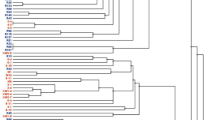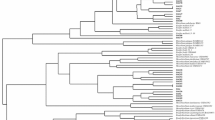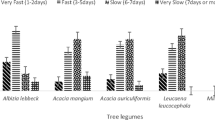Abstract
This study characterized genetically 30 fast-growing rhizobial strains isolated from nodules of Asian and modern soybean genotypes that had been inoculated with soils from disparate regions of Brazil. Analyses by rep-PCR (ERIC and REP) and RAPD indicated a high level of genetic diversity among the strains. The RFLP-PCR and sequencing analysis of the 16S rRNA genes indicated that none of the strains was related to Sinorhizobium (Ensifer) fredii, whereas most were related to Rhizobium tropici (although they were unable to nodulate Phaseolus vulgaris) and to Rhizobium genomic species Q. One strain was related to Rhizobium sp. OR 191, while two others were closely related to Agrobacterium (Rhizobium) spp.; furthermore, symbiotic effectiveness with soybean was maintained in those strains. Five strains were related to Bradyrhizobium japonicum and B. elkanii, with four of them being similar to strains carried in Brazilian inoculants, therefore modifications in physiological properties, as a shorter doubling time might have resulted from adaptation to local conditions. Phospholipid fatty acid analysis (PFLA) was less precise in delineating taxonomic relationships. The strains fit into eight Nod-factor profiles that were related to rhizobial species, but not to N2-fixation capacity or competitiveness. The data obtained highlight the diversity and promiscuity of rhizobia in the tropics, being capable of nodulating exotic legumes and might reflect ecological strategies to survive in N-poor soils; in addition, the diversity could also represent an important source of efficient and competitive rhizobial strains for the tropics. Putative new rhizobial species were detected only in undisturbed soils. Three species (R. tropici, B. japonicum and B. elkanii) were found under the more sustainable management system known as no-till, while the only species isolated from soils under conventional till was R. tropici. Those results emphasize that from the moment that agriculture was introduced into undisturbed soils rhizobial diversity has changed, being drastically reduced when a less sustainable soil management system was adopted.




Similar content being viewed by others
References
Acosta-Durán C, Martínez-Romero E (2002) Diversity of rhizobia from nodules of the leguminous tree Gliricidia sepium, a natural host of Rhizobium tropici. Arch Microbiol 178: 161–164
Alberton O, Kaschuk G, Hungria M (2006) Sampling effects on the assessment of genetic diversity of rhizobia associated with soybean and common bean. Soil Biol Biochem 38: 1298–1307
Anyango B, Wilson KL, Beynon JL, Giller KE (1995) Diversity of rhizobia nodulating Phaseolus vulgaris L. in two Kenyan soils with contrasting pHs. Appl Environ Microbiol 61: 4016–4021
Balatti PA, Pueppke SG (1992) Identification of North American soybean lines that form nitrogen-fixing nodules with Rhizobium fredii USDA 257. Can J Plant Sci 72: 49–55
Batista JS, Hungria M, Barcellos FG, Ferreira, MC, Mendes IC (2006) Variability in Bradyrhizobium japonicum and B. elkanii seven years after introduction of both the exotic microsymbiont and the soybean host in a Cerrados soil. Microbial Ecol (in press)
Boddey LH, Hungria M (1997) Phenotypic grouping of Brazilian Bradyrhizobium strains which nodulated soybean. Biol Fert Soils 25: 407–415
Broughton WJ, Heycke N, Meyer HZA, Pankhurst CE (1984) Plasmid-linked nif and nod genes in fast-growing rhizobia that nodulate Glycine max, Psophocarpus tetragonolobus and Vigna unguiculata. Proc Natl Acad Sci USA 81: 3093–3097
Buendía-Clavería AM, Chamber M, Ruíz-Saínz JE (1989) A comparative study of the physiological characteristics, plasmid content and symbiotic properties of different Rhizobium fredii strains. Syst Appl Microbiol 12: 203–209
Caballero-Mellado J, Martínez-Romero E (1999) Soil fertilization limits the genetic diversity of Rhizobium in bean nodules. Symbiosis 26: 111–121
Chen LS, Figueredo A, Pedrosa FO, Hungria M (2000) Genetic characterization of soybean rhizobia in Paraguay. Appl Environ Microbiol 66: 5099–5103
Chen WX, Yan GH, Li JL (1988) Numerical taxonomic study of fast-growing soybean rhizobia and a proposal that Rhizobium fredii be assigned to Sinorhizobium gen. nov. Int J Syst Bacteriol 38: 393–397
Chueire LMO, Hungria M (1997) N2-fixation ability of Brazilian soybean cultivars with Sinorhizobium fredii and Sinorhizobium xinjiangensis. Plant Soil 196: 1–5
Dagutat H, Stein PL (1995) Taxonomy and distribution of rhizobia indigenous to South African soils. In: Tikonovich IA, Provoporv NA, Romanov VI, Newton WE (eds) Nitrogen fixation: fundamentals, applications. Kluwer Academic Publishers, Dordrecht, pp 683
de Bruijn FJ (1992) Use of repetitive (repetitive extragenic palindromic and enterobacterial repetitive intergeneric consensus) sequences and the polymerase chain reaction to fingerprint the genomes of Rhizobium meliloti isolates and other soil bacteria. Appl Environ Microbiol 58: 2180–2187
de Lajudie PD, Willems A, Pot B, Dewettinck D, Maestrojuan G, Neyra M, Collins MD, Dreyfus B, Kersters K, Gillis M (1994) Polyphasic taxonomy of rhizobia: Emendation of the genus Sinorhizobium and description of Sinorhizobium meliloti comb. nov., Sinorhizobium saheli sp. nov. and Sinorhizobium teranga sp. nov. Int J Syst Bacteriol 44: 715–733
Devine TE (1985) Nodulation of soybean plant introduction lines with the fast-growing rhizobial strain USDA 205. Crop Sci 25: 354–356
Dowdle SF, Bohlool BB (1985) Predominance of fast-growing Rhizobium japonicum in a soybean field in the People’s Republic of China. Appl Environ Microbiol 50: 1171–1176
Ferreira MC, Andrade DS, Chueire LMO, Takemura SM, Hungria M (2000) Tillage method and crop rotation effects on the population sizes and diversity of bradyrhizobia nodulating soybean. Soil Biol Biochem 32: 627–637
Ferreira MC, Hungria M (2002) Recovery of soybean inoculant strains from uncropped soils in Brazil. Field Crops Res 79: 139–152
Galli-Terasawa LV, Glienke-Blanco C, Hungria M (2003) Diversity of soybean rhizobial population adapted to a Cerrados soil. World J Microbiol Biotechnol 19: 933–939
Gogarten JP, Townsend JP (2005) Horizontal gene transfer, genome innovation and evolution. Nature Rev Microbiol 3: 679–687
Grange L, Hungria M (2004) Genetic diversity of indigenous common bean (Phaseolus vulgaris) rhizobia in two Brazilian ecosystems. Soil Biol Biochem 36: 1389–1398
Harrison SP, Mytton LR, Skøt L, Dye M, Cresswell A (1992) Characterization of Rhizobium isolates by amplification of DNA polymorphisms using random primers. Can J Microbiol 38: 1009–1015
Hartman JH (1967) Modern factor analysis. University Press, Chicago, IL
Hernandez-Lucas I, Segovia L, Martínez-Romero E, Pueppke SG (1995) Phylogenetic relationships and host range of Rhizobium spp. that nodulate Phaseolus vulgaris L. Appl Environ Microbiol 61: 2775–2779
Hollaway GJ, Gillings MR, Fahy PC (1997) Use of fatty acid profiles and repetitive element polymerase chain reaction (PCR) to assess the genetic diversity of Pseudomonas syringae pv. pisi and Pseudomonas syringae pv. syringae isolated from field peas in Australia. Aust J Plant Pathol 26: 98–108
Hungria M, Andrade DS, Chueire LMO, Probanza A, Guttierrez-Mañero FJ, Megías M (2000) Isolation and characterization of new efficient and competitive bean (Phaseolus vulgaris L.) rhizobia from Brazil. Soil Biol Biochem 32: 1515–1528
Hungria M, Andrade DS, Colozzi-Filho A, Balota EL (1997) Interação entre microrganismos do solo, feijoeiro e milho em monocultura e consórcio. Pesq Agropec Bras 32: 807–818
Hungria M, Boddey LH, Santos MA, Vargas MAT (1998) Nitrogen fixation capacity and nodule occupancy by Bradyrhizobium japonicum and B. elkanii strains. Biol Fert Soils 27: 393–399
Hungria M, Campo RJ, Chueire LM, Grange L, Megias M (2001a) Symbiotic effectiveness of fast-growing rhizobial strains isolated from soybean nodules in Brazil. Biol Fert Soils 33: 387–394
Hungria M, Campo RJ, Mendes IC, Graham PH (2006) Contribution of biological nitrogen fixation to the nitrogen nutrition of grain crops in the tropics: the success of soybean (Glycine max L. Merr.) in South America. In: Singh RP, Shankar N, Jaiwal PK (Eds.), Nitrogen nutrition in plant productivity. Studium Press, Houston, Texas, pp 43–93
Hungria M, Chueire LMO, Coca RG, Megías M (2001b) Preliminary characterization of fast growing rhizobial strains isolated from soyabean nodules in Brazil. Soil Biol Biochem 33: 1349–1361
Hungria M, Nishi CYM, Cohn J, Stacey G (1996) Comparison between parental and variant soybean Bradyrhizobium strains with regard to the production of lipo-chitin nodulation signals, early stages of root infection, nodule occupancy, and N2 fixation. Plant Soil 186: 331–341
Hungria M, Stacey G (1997) Molecular signals exchanged between host plants and rhizobia: Basic aspects and potential application in agriculture. Soil Biol Biochem 29: 819–830
Hungria M, Vargas MAT (2000) Environmental factors affecting N2 fixation in grain legumes in the tropics, with an emphasis on Brazil. Field Crops Res 65: 151–164
Jaccard P (1912) The distribution of flora in the alpine zone. New Phytol 11: 37–50
Jarvis BDW, Tighe SW (1994) Rapid identification of Rhizobium species based on cellular fatty acid analysis. Plant Soil 161: 31–44
Jordan DC (1982) Transfer of Rhizobium japonicum Buchanan (1980) to Bradyrhizobium gen. nov., a genus of slow growing root-nodule bacteria from leguminous plants. Int J Syst Bacteriol 32: 136–139
Judd AK, Schneider M, Sadowsky MJ, de Bruijn FJ (1993) Use of repetitive sequences and the polymerase technique to classify genetically related Brayrhizobium japonicum serocluster 123 strains. Appl Environ Microbiol 59: 1702–1708
Kaschuk G, Hungria M, Santos JC, Berton-Junior JF (2006) Differences in common bean rhizobial populations associated with soil tillage management in southern Brazil. Soil Till Res 87: 205–207
Keyser HH, Bohlool BB, Hu TS, Weber DF (1982) Fast-growing rhizobia isolated from root nodules of soybeans. Science 215: 1631–1632
Khbaya B, Neyra M, Normand P, Zerhari Z, Filali-Maltouf A (1998) Genetic diversity and phylogeny of rhizobia that nodulate Acacia spp. in Morocco assessed by analysis of rRNA genes. Appl Environ Microbiol 64: 4912–4917
Kuykendall LD, Saxena B, Devine TE, Udell SE (1992) Genetic diversity in Bradyrhizobium japonicum Jordan (1982) and a proposal for Bradyrhizobium elkanii sp. nov. Can J Microbiol 38: 501–505
Lafay B, Burdon JJ (1998) Molecular diversity of rhizobia occurring on native shrubby legumes in southeastern Australia. Appl Environ Microbiol 64: 3989–3997
Laguerre G, van Berkum P, Amarger N, Prevost D (1997) Genetic diversity of rhizobial symbionts isolated from legume species within the genera Astragalus, Oxytropis, and Onobrychis. Appl Environ Microbiol 63: 4748–4758
Lopes ES, Giardini AR, Kiihl RAS (1976) Presença e eficiência de Rhizobium japonicum em solos cultivados ou não com soja, no Estado de São Paulo. Bragantia 35: 389–396
Madrzak CJ, Golinska B, Króliczak J, Pudelko K, Lazewska D, Lampka B, Sadowsky M (1995) Diversity among field populations of Bradyrhizobium japonicum in Poland. Appl Environ Microbiol 61: 1194–1200
Martinez E, Palácios R, Sáchez F (1987) Nitrogen-fixing nodules induced by Agrobacterium tumefaciens harboring Rhizobium phaseoli plasmids. J Bacteriol 169: 2828–2834
Martínez-Romero E, Segovia E, Mercante FM, Franco AA, Graham PH, Pardo MA (1991) Rhizobium tropici, a novel species nodulating Phaseolus vulgaris L. beans and Leucaena sp. trees. Int J Syst Bacteriol 41: 417–426
Menna P, Hungria M, Barcellos FG, Bangel EV, Martínez-Romero E (2006) Molecular phylogeny based on the 16S rRNA gene and host specificity of elite rhizobial strains used in Brazilian commercial inoculants. Syst Appl Microbiol 29: 315–332
Mercante FM, Cunha CO, Straliotto R, Ribeiro-Junior W, Vanderleyden J, Franco AA (1998) Leucaena leucocephala as a trap-host for Rhizobium tropici strains from the Brazilian “Cerrado” region. R Microbiol 29: 49–58
Mhamdi R, Jebara M, Aouni ME, Ghir R, Mars M (1999) Genotypic diversity and symbiotic effectiveness of Phaseolus vulgaris L. grown in Tunisian soils. Biol Fert Soils 28: 313–320
Moreira FMS, Gillis M, Pot B, Kersters K, Franco AA (1993) Characterization of rhizobia isolated from different divergence groups of tropical Leguminosae by comparative polyacrylamide gel electrophoresis of their total proteins. Syst Appl Microbiol 16: 135–136
Nishi CYM, Boddey LH, Vargas MAT, Hungria M (1996) Morphological, physiological and genetic characterization of two new Bradyrhizobium strains recently recommended as Brazilian commercial inoculants for soybean. Symbiosis 20: 147–162
Novikova NY, Safronova V (1992) Transconjugants of Agrobacterium radiobacter harbouring sym genes of R. galegae can form an effective symbiosis with Medicago sativa. FEMS Microbiol Lett 93: 262–268
Park MS, Jung SR, Lee MS, Kim KO, Do JO, Lee KH, Kim SB, Bae KS (2005) Isolation and characterization of bacteria associated with two sand dune plant species, Calystegia soldanella and Elymus mollis. J Microbiol 43: 219–227
Peres JRR (1979) Seleção de estirpes de Rhizobium japonicum e competitividade por sítios de infecção nodular em cultivares de soja (Glycine max (L.) Merrill). UFRGS-FA, Porto Alegre, Brazil. (M.Sc. Thesis)
Richardson AE, Viccars LAA, Watson JM, Gibson AH (1995) Differentiation of Rhizobium strains using the polymerase chain reaction with random and directed primers. Soil Biol Biochem 27: 515–524
Rodriguez-Navarro DN, Ruiz-Sainz JE, Buendía-Clavería A, Santamaria C, Balatti PA, Krishnan HB, Pueppke SG (1996) Characterization of fast-growing rhizobia from nodulated soybean [Glycine max (L.) Merr.] in Vietnam. Syst Appl Microbiol 9: 240–248
Romero F, Buendia-Claveria A, Ruíz-Saínz JE (1993) Broad host-range effective mutants of Rhizobium fredii strains. J Appl Bacteriol 74: 610–619
Santos MA, Vargas MAT, Hungria M (1999) Characterization of soybean bradyrhizobia strains adapted to the Brazilian Cerrados Region. FEMS Microbiol Ecol 30: 261–272
Scholla MH, Elkan GH (1984) Rhizobium fredii sp. nov., a fast-growing species that effectively nodulates soybeans. Int J Syst Bacteriol 34: 484–486
Selenska-Pobell S, Gigova L, Petrova N (1995) Strain-specific fingerprints of Rhizobium galegae generated by PCR with arbitrary and repetitive primers. J Appl Bacteriol 79: 425–431
Sneath PBA, Sokal RR (1973) Numerical taxonomy. W.H. Freeman & Co, San Francisco, USA
Stowers MD, Eaglesham AR (1984) Physiological and symbiotic characteristics of fast-growing Rhizobium japonicum. Plant Soil 77: 3–14
Straliotto R, Cunha CO, Mercante FM, Franco AA, Rumjanek NG (1999) Diversity of rhizobia nodulating common beans (Phaseolus vulgaris L.) isolated from Brazilian tropical soils. An Acad Bras Ciênc 71: 531–543
Sullivan JT, Ronson CW (1995) Evolution of rhizobia by acquisition of a 500-kb symbiosis island that integrates into a phe-tRNA gene. Proc Natl Acad Sci USA 95: 5145–5149
Terefework Z, Nick G, Suomalaine S, Paulin L, Lindström K (1998) Phylogeny of Rhizobium galegae with respect to other rhizobia and agrobacteria. Int J Syst Bacteriol 48: 349–356
van Rossum D, Schuurmans FP, Gillis M, Muyotcha A, van Verseveld HW, Stouthamer AH, Boogerd FC (1995) Genetic and phenetic analyses of Bradyrhizobium strains nodulating peanut (Arachis hypogaea L.) roots. Appl Environ Microbiol 61: 1599–1609
Vargas MA, Suhet AR (1980) Efeito de tipos e níveis de inoculantes na soja cultivada em um solo de cerrado. Pesq Agropec Bras 15: 343–347
Vincent JM (1970) Manual for the practical study of root nodule bacteria. Blackwell, Oxford, UK
Wang ET, van Berkum P, Beyene D, Sui XH, Dorado O, Chen WX, Martinez-Romero E (1998) Rhizobium huautlense sp. nov., a symbiont of Sesbania herbacae that has a close phylogenetic relationship with Rhizobium galegae. Int J Syst Bacteriol 48:687–699
Xu LM, Ge C (1984) Physiological-biochemical characteristics and symbiotic responses of the fast-growing Rhizobium japonicum. Soybean Sci 3: 102–109
Young CC, Chang JY, Chao CC (1988) Physiological and symbiotic characteristics of Rhizobium fredii isolated from subtropical-tropical soils. Biol Fert Soils 5: 350–354
Young JM (2003) The genus name Ensifer Casida (1982) takes priority over Sinorhizobium Chen et al. 1988, and Sinorhizobium morelense Wang et al. (2002) is a later synonym of Ensifer adhaerens Casida 1982. Is the combination ‘Sinorhizobium adhaerens’ (Casida 1982) Willems et al. (2003) legitimate? Request for an Opinion. Int J Syst Evol Microbiol 53: 2107–2110
Young JPW, Downer H, Eardly BD (1991) Phylogeny of the phototrophic Rhizobium strain BTAi1 by polymerase chain reaction-based sequencing of a 16S rRNA gene segment. J Bacteriol 173: 2271–2277
Young JM, Kuykendall LD, Martínez-Romero E, Kerr A, Sawada H (2001) A revision of Rhizobium Frank 1889, with an emended description of the genus, and the inclusion of all species of Agrobacterium Conn (1942) and Allorhizobium undicola de Lajudie et al. (1998) as new combinations: Rhizobium radiobacter, R. rhizogenes, R. rubi, R. undicola and R. vitis. Int J Syst Evol Microbiol 51: 89–103
Young JM, Kuykendall LD, Martínez-Romero E, Kerr A, Sawada H (2003) Classification and nomenclature of Agrobacterium and Rhizobium – a reply to Farrand et al. (2003). Int J Syst Evol Microbiol 53: 1689–1695
Acknowledgements
The research group in Brazil was supported by FINEP/CNPq-Conselho Nacional de Desenvolvimento Científico e Tecnológico/MCT (PRONEX, Instituto do Milênio, Edital Universal and CABBIO). L. M. O. Chueire and M. Hungria acknowledge fellowships from CNPq. The authors thank to Dr. Allan R. J. Eaglesham for suggestions on the manuscript and to Fábio L. Mostasso for help in the analysis.
Author information
Authors and Affiliations
Corresponding author
Rights and permissions
About this article
Cite this article
Hungria, M., Chueire, L.M.O., Megías, M. et al. Genetic diversity of indigenous tropical fast-growing rhizobia isolated from soybean nodules. Plant Soil 288, 343–356 (2006). https://doi.org/10.1007/s11104-006-9125-0
Received:
Accepted:
Published:
Issue Date:
DOI: https://doi.org/10.1007/s11104-006-9125-0




